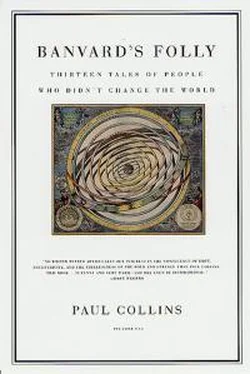Toward the end of these London shows, Banvard found himself increasingly dogged by imitators--there were fifty competing panoramas in the 1849-50
season alone. In addition to suffering competition from longtime rival John Rowson Smith, Banvard now had scurrilous accusations of plagiarism flung at him by fellow expatriate portraitist George Caitlin, a jealous painter who had
"befriended" Banvard in order to borrow money. Banvard also found his shows being set upon by the spies of his rivals, who hired art students to sit in the audience and sketch his work as it rolled by.
We know that a form of art has permeated a culture when cheap imitations appear, and even more so when parodies of these imitations emerge. There is a long-forgotten work in this vein by American humorist Artemus Ward, which was published posthumously as Artemus Ward, His Panorama (1869). Ward spent the last years of his life working in London, and had probably attended some of the numerous panoramic travelogues and travesties that darted about in Banvard's wake. His panorama, as shown by illustrations of the supposed stage (which, as often as not, is obscured by a faulty curtain), consists of a discourse on San Francisco and Salt Lake City, often interrupted by crapulous bits of tangential mumbling in small type:
If you should be dissatisfied with anything here tonight-I will admit you all free in New Zealand--if you will come to me there for the orders.
This story hasn't anything to do with my Entertainment, I know--but one of the principle features of my Entertainment is that it contains so many things that don't have anything to do with it.
For ads reproduced in the book, Ward munificently assures his audiences that his lecture hall has been lavishly equipped with "new doorknobs." But Banvard's most serious rivals were not such bumblers, and so he had to swing back into action. Locking himself in the studio again, he created another Mississippi panorama. Where the first panorama had been a view of the eastern bank, this new painting depicted the western bank. He then placed the London
show in the hands of a new narrator and toured Britain himself with the second painting for two years, bringing in nearly 100,000 more viewers.
What might Banvard have done with these two paintings had he placed them onstage together? Angled in diagonally from each side to terminate just behind the podium, moving in unison, they would have provided a sort of stereoptical effect of floating down the center of the Mississippi River. It would have been the first "surround multimedia." For all of Banvard's innovation, though, there is no record of such an experiment.
Not all of Banvard's time in London was spent on his own art. In his spare hours, he haunted the Royal Museum; he was fascinated by its massive collection of Egyptian artifacts. He soon became a protege of the resident Egyptologists, and under their tutelage he learned to decipher hieroglyphics--the only American of his time, by some accounts, to learn this skill. For decades afterward, he was able to pull sizable crowds to his lectures on the reading of hieroglyphics.
Banvard moved his show to Paris, where his success continued unabated for another two years. He was now also a family man: a daughter, Gertrude, was born in London, and a son, John Jr., was born in Paris. Having children scarcely slowed down his travels; on the contrary, he left the family to spend the next year on an artistic pilgrimage to the Holy Land. In a reprise of his American journey, he sailed down the Nile and filled up notebooks with sketches. But he no longer had to sleep with these notebooks as a pillow. He was now wealthy enough to travel in comfort, and he bought thousands of artifacts along the way-a task assisted by his unusual ability at translating hieroglyphics.
These travels were to become the basis for yet two more panoramas: one of Palestine, and the other of the trip down the Nile. Neither was to earn him as much as his Mississippi panorama; the market was now flooded with imitations, and the public was beginning to weary of the panoramic lecture. Even so, Banvard's abilities were greater than ever. One American reviewer commented in 1854 in Ballou's Pictorial Drawing Room Companion: Mr. Banvard made a name and fortune by his three mile panorama of the Mississippi. It was one of those cases in which contemporary justice is bestowed upon true merit .... His sole teacher in his art is Nature; there are few conventionalisms in his style. His present great work is far superior in artistic merit to his Mississippi--showing his rapid improvement; its effect is enhanced by its great height.
Just eight years after his voyage down the Mississippi, he had become both the most famous living artist in the world and the richest artist in history.
Banvard returned to the United States with his family in the spring of 1852.
He was a fantastically wealthy man, so wealthy that he could retire to a castle and casually dabble in the arts for the rest of his life. And at first that's exactly what he did.
The world's most famous artist needed an equally imposing home to live in.
Accordingly, he bought a sixty-acre lot on Long Island and proceeded to build a replica of Windsor Castle. When the local roads didn't meet the needs of his castle, he simply built one of his own. He dubbed the castle Glenada in honor of his daughter, Ada; neighbors, who were alternately aghast and awed by the unheard-of construction expenses being incurred, simply dubbed it Banvard's Folly.
A reporter touring the site was kinder in his appraisal of Banvard's castle:
It has a magnificent appearance, reminding you forcibly of some of the quaint old castles nestled among the glens of old Scotland. ... There are nine offices on the first floor, as you enter from the esplanade, viz., the drawing-room, parlors, conservatory, anteroom, servant's room, and several chambers. The second story contains the nursery, school-room, guest chambers, bath, library, study, etc., with the servants' rooms in the towers. The basement is occupied with the offices, store-rooms, etc. Although the facade extends in front one hundred and fifteen feet, still Mr. Banvard says his castle is not completed, as he plans adding a large donjon or keep, to be occupied by his studio, painting-room, and a museum for the reception of the large collection of curiosities which he has gathered in all parts of the world .... it has been proposed to change the name of the place [Cold Spring Harbor] and call it BANVARD ....
Not surprisingly, the residents of the town failed to see the charm of this last proposal.
Still, Banvard spent the next decade in relative prosperity and modest continued artistic success. Indeed, his artistic horizons broadened each year.
In 1861, he provided the Union military with his own hydrographic charts of the Mississippi River. General Fr@emont wrote back personally to thank him for his expert assistance. That same year, Banvard provided the illustration for the first successful chromolithograph in America. The process was unique in duplicating both the color and the canvas texture of the original illustration, which Banvard had titled "The Orison." The result was a tremendous success and helped assure his continued reputation as a technically innovative artist.
Banvard then turned his attention back to his first love: the theater. Amasis, or, The Last of the Pharaohs was a massively staged "biblical-historical"
drama that ran in Boston in 1864. Banvard had both written the play and painted its enormous scenery, and was gratified by its warm reception among critics. It seemed to him that there was nothing that he could not succeed at.
Even as Banvard displayed his Egyptian artifacts to guests at Glenada, the role of museums was changing rapidly in America. By 1780, the "cabinet of wonder" kept by wealthy dilettantes had evolved into the first recognizable museum, operated by Charles Peale in Philadelphia. Joined later by John Scudder's American Museum in New York, these museums focused on educational lectures and displays--illustrations and examples of unusual natural objects, as well as the occasional memento.
Читать дальше











